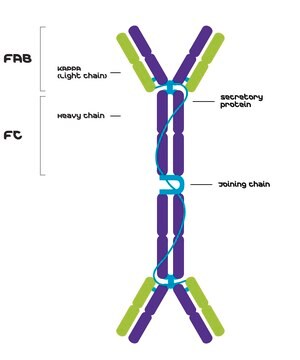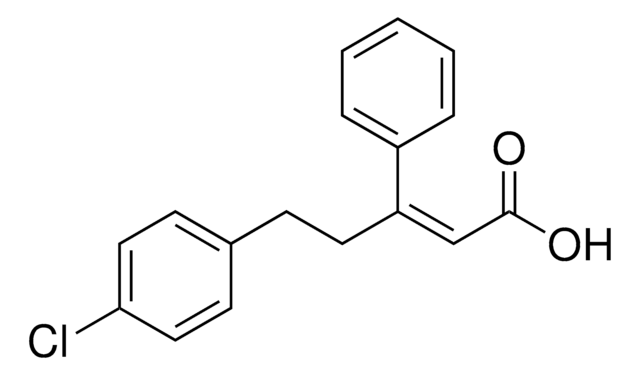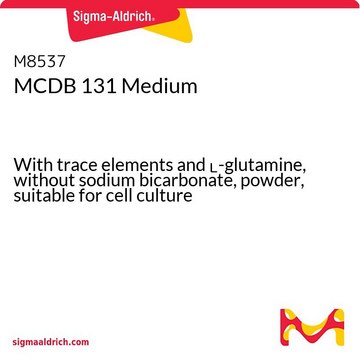M3769
Medium 199
Modified, with Earle′s salts, without L-glutamine, sodium bicarbonate, and phenol red, powder, suitable for cell culture
Synonym(s):
M199 Medium, TCM 199
Sign Into View Organizational & Contract Pricing
All Photos(1)
About This Item
UNSPSC Code:
12352207
NACRES:
NA.71
Recommended Products
Quality Level
form
powder
technique(s)
cell culture | mammalian: suitable
components
L-glutamine: no
phenol red: no
HEPES: no
sodium pyruvate: no
Earle’s salts (5% CO2): yes
NaHCO3: no
shipped in
ambient
storage temp.
2-8°C
Looking for similar products? Visit Product Comparison Guide
General description
Medium 199 is a combination of vitamins, amino acids, and other factors that were originally developed as a completely defined media formulation for the culture of primary explants. This medium, when properly supplemented has broad applicability, particularly for non-transformed cells. Medium 199 is widely used for vaccine production, in vitro cultivation of primary pancreatic explants, and lens tissues.
Application
Medium 199 has been used:
- to culture the primary human umbilical vein endothelial cells (HUVECs) for use in cell viability assay
- to flush the uterine horn of gilts to recover day 12 conceptuses from uteri
- to culture the peritoneal cells and immortalized human mesothelial cells (MeT-5A and ATCC-CRL-9444)
Quantity
Formulated to contain 9.4 grams of powder per liter of medium.
Reconstitution
Supplement with 0.1 g/L L-glutamine, 2.2 g/L sodium bicarbonate.
also commonly purchased with this product
Product No.
Description
Pricing
supplement
Storage Class Code
13 - Non Combustible Solids
WGK
WGK 1
Flash Point(F)
Not applicable
Flash Point(C)
Not applicable
Certificates of Analysis (COA)
Search for Certificates of Analysis (COA) by entering the products Lot/Batch Number. Lot and Batch Numbers can be found on a product’s label following the words ‘Lot’ or ‘Batch’.
Already Own This Product?
Find documentation for the products that you have recently purchased in the Document Library.
Customers Also Viewed
Agnieszka Blitek et al.
Theriogenology, 127, 88-101 (2019-01-25)
Peroxisome proliferator-activated receptors (PPARs) are members of the nuclear receptor family of ligand-dependent transcription factors. PPARs are important regulators of glucose and fatty acid metabolism, apoptosis, angiogenesis, cell proliferation and differentiation, and immune response. Their possible role in the female
Diane G Edmondson et al.
mBio, 12(1) (2021-02-25)
The bacterium that causes syphilis, Treponema pallidum subsp. pallidum, has now been cultured in vitro continuously for periods exceeding 3 years using a system consisting of coculture with Sf1Ep rabbit epithelial cells in TpCM-2 medium and a low-oxygen environment. In
Kenneth W Olsen et al.
Molecular vision, 17, 270-278 (2011-02-02)
The crystalline lens is a unique cellular organ that performs metabolic processes while maintaining transparency for optical functionality. Mitochondria play a role in providing cells with aerobic respiration necessary for these metabolic processes. Using menadione, a mitochondria-specific inhibitor of the
Klaus Kratochwill et al.
Nephrology, dialysis, transplantation : official publication of the European Dialysis and Transplant Association - European Renal Association, 27(3), 937-946 (2011-08-23)
Exposure of mesothelial cells to peritoneal dialysis fluids (PDF) results in cytoprotective cellular stress responses (CSR) that counteract PDF-induced damage. In this study, we tested the hypothesis that the CSR may be inadequate in relevant models of peritoneal dialysis (PD)
Martina Maccesi et al.
Parasites & vectors, 12(1), 493-493 (2019-10-24)
Over the past five years, as a public service to encourage and accelerate drug discovery for diseases of poverty, the Medicines for Malaria Venture (MMV) has released box sets of 400 compounds named the Malaria, Pathogen and Stasis Boxes. Here
Our team of scientists has experience in all areas of research including Life Science, Material Science, Chemical Synthesis, Chromatography, Analytical and many others.
Contact Technical Service







